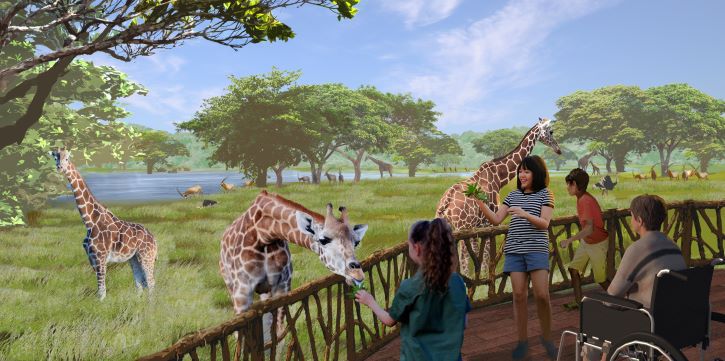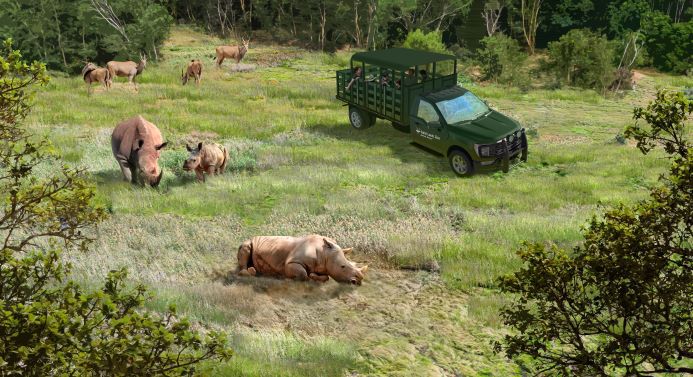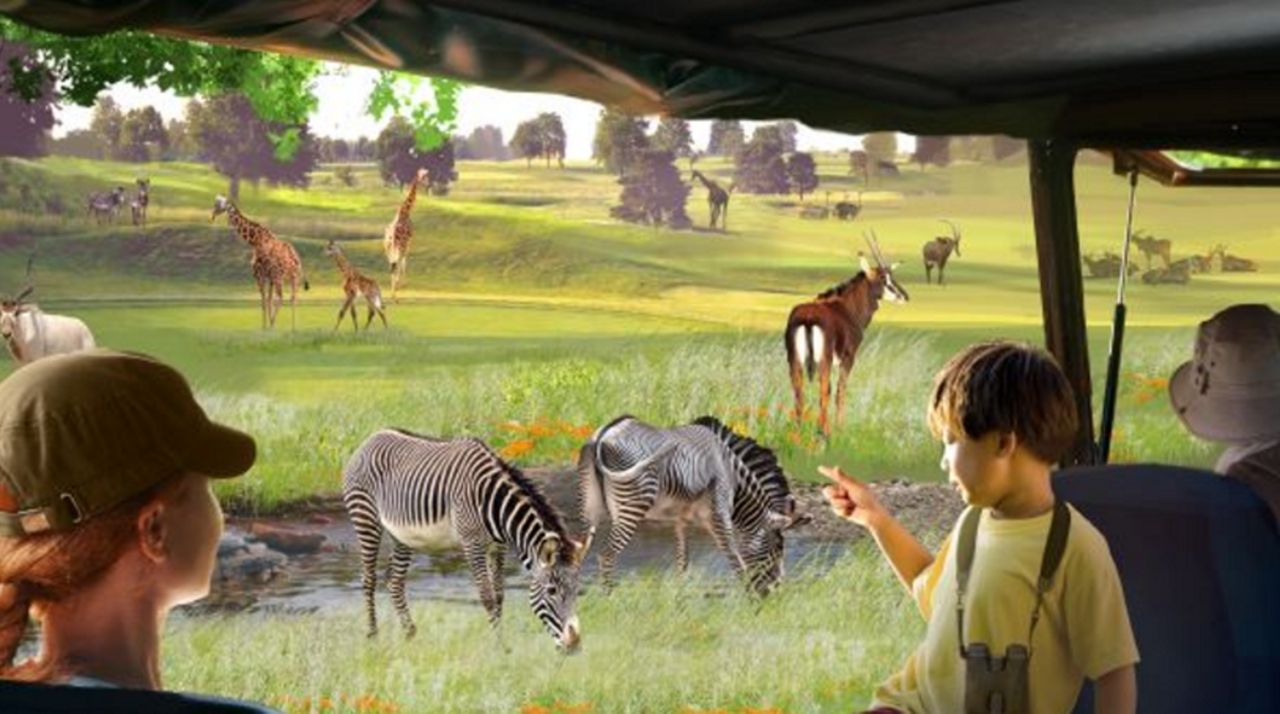ST. LOUIS – The St. Louis Zoo WildCare Park is expected to open to the public in 2027, and animals will start arriving next year. There will also be safari rides to see giraffes, rhinos, and more, an 11-story observation tower, and a glamping area. Those are just some of the updates the St. Louis Zoo released today about the north St. Louis County attraction.
WildCare Park construction
The development is expected to cost an estimated $230 million with funding coming from several sources. WildCare Park officials say several older buildings had to be demolished because renovations were not feasible and were cost prohibitive. The demolition work is nearly complete.
A fence is being installed and grading has begun around the perimeter of the property. Construction on the fence will likely continue through the first couple months of 2023.
“There are a lot of complexities associated with building a large zoological park like this. The enormity and importance – size and scope – are incredible,” said Jo-Elle Mogerman, Ph.D., Saint Louis Zoo WildCare Park Director. “Understandably, the COVID-19 pandemic and supply chain issues – including long lead times of up to one year for key materials like steel, wood and fencing – have slowed down many aspects of the process.
Dr. Mogerman says the team is still able to continue with its planning as well as its biodiversity studies.

The animals
Animals will start arriving at the 425-acre WildCare Park in 2023 for a pilot pasture. WildCare Park officials say animal species are being selected that will thrive in Missouri’s variable seasonal climate.
“We have chosen species that will benefit the most from large living spaces. Giraffes, white rhinos and all of the equid/horse species have large natural ranges in the wild, so providing these species with large spaces at WildCare Park will allow them to display the full array of their natural behaviors,” said Martha Fischer, General Curator at WildCare Park.
The species selected for the safari areas are a mix of endangered and non-endangered species, although endangered species were given the highest priority during selection.
Some of the species are currently present at the Zoo, but many of the species at WildCare Park will be different than the Zoo to offer guests the opportunity to see a diversity of species across both campuses.
While subject to change based on conservation needs, here is the initial list of animals that might call WildCare Park home:
Giraffe
Grevy’s zebra
Greater kudu
Addax
Bongo
Roan antelope
Somali wild ass
Przewalski’s horse
Scimitar-horned oryx
Waterbuck
Nile lechwe
Banteng
Gazelle (various species)
White rhino
Eland
Sable antelope
Bactrian camel
Ostrich
Guest Experiences
WildCare Park will allow guests to be immersed in nature and animal pastures. “Every visit will be a new adventure,” said Dr. Mogerman.
While subject to change, here is the initial list with brief descriptions of the guest experiences that will likely be at WildCare Park:
Two 30-minute safaris – The safaris will be from vehicles similar to the size of a school bus that seat 30-40 passengers. During the safaris, animal experts will share stories and describe the behaviors of the animals as well as the care they receive and the field conservation work done by conservationists through the Saint Louis Zoo WildCare Institute. During both safaris, guests can learn what they can do to help save species from extinction and support wildlife.

Woodland Safari – Guests can enjoy viewing animals within this 63-acre natural wooded habitat that is interspersed with grassy areas. The star of the Woodland Safari is the white rhino. A group of up to 10 white rhinos will have free range throughout Woodland Safari, living with approximately 30 other larger ungulates – for example, eland and sable antelope – and ostriches.
Savanna Safari – This 101-acre pasture looks more like a traditional savanna with large grassy areas dotted with trees and includes several lakes and ponds. From a safari vehicle, guests can enjoy viewing approximately 100 animals, including a herd of up to 20 giraffes as well as ungulates like Grevy’s zebra, banteng, greater kudu, scimitar-horned oryx, and waterbucks.
Walking safari experience – This multiple-acre habitat will allow guests to have an immersive experience as they wander through the habitat on a path with animals all around them.
A “zooseum” – This 5,000-8,000 square foot interactive indoor zoo-museum-science center that will use augmented reality (AR) and virtual reality (VR) as well as other technologies to help guests feel how animals experience the world.
Nature adventure area – 60 acres of land geared toward families and children who can (re)discover nature surrounded by native Missouri wildlife flora and fauna.
Safari observation tower – For a fee, guests can enjoy a one-of-a-kind experience by going 11 stories up in the air to take in 360-degree views of WildCare Park, the cityscape and the Missouri-Mississippi River Confluence.
Premium safaris – For a fee, guests can take a guided tour with an animal expert in two ways.
Board the back of an open-air truck that seats about 12 guests and go “off-road” for exciting up-close experiences with the animals. There would be opportunities to feed giraffes and other species from the truck as well as get a close up of the Kent Family Conservation and Animal Science Center.
Climb into a jeep that can seat four guests and spend a few hours experiencing educational interactions with WildCare Park animal care professionals, visit behind-the-scenes areas in pastures and barns, and more.
Giraffe feeding – This unique animal experience will have guests at head height to giraffes. For a fee, guests can purchase browse or lettuce to offer to the giraffes getting up close to their 18-inch tongues.
Glamping – Spend the night glamping – or glamorous camping – in one of 10 private luxury cabins. Guests can just relax or embark on a safari ride, take a nature hike, enjoy a meal and/or chat with animal care or research experts. Guests can even participate in an activity that is a positive action for wildlife – for example, building a bat house. The three-season cabins have incredible views into the Savanna Safari and will have their own full en suite bathrooms.
Restaurant – Enjoy a delicious meal or sip on a beverage at the WildCare Park restaurant. Indoor and outdoor seating will be available. The outdoor seating has views looking into a conservation pasture.
Event center – Book a special event at WildCare Park. The event center will accommodate smaller functions and large celebrations as there will be two ballrooms. Located in the center of WildCare Park, there will be breathtaking views of the Savanna Safari and incredible experiences, like giraffe feedings right off of the deck of the event center.
Kent Family and Animal Science Center
The Kent Family Conservation and Animal Science Center will be a dedicated facility to sustain endangered and threatened species.
The Kent Family Conservation and Animal Science Center includes 61 acres of secluded conservation area with pastures and barns to maintain and grow populations of endangered ungulates (hoofed mammals).
The Kent Family Conservation and Animal Science Center will be home to six or more endangered species living in large 5- to 10-acre single-species pastures. The initial species that will live in this area are Grevy’s zebra, addax, bongo, Przewalski’s horse, roan antelope and Somali wild ass. Initially, there will be five modular, utilitarian barns in this area with up to 12 interconnected pastures of varying sizes.
Biodiversity Studies
Zoo conservationists continue to study the native animals and plants that live in and around WildCare Park. The information gathered helps plan for the development of the property more holistically, including designation of no-construction zones to protect key native wildlife areas, as well as enhancement of terrestrial and aerial corridor zones to allow for free wildlife movement on, around and through the property.
Currently, there are eight areas of study: bats, birds, coyotes and foxes, invertebrates/pollinators, plants, reptiles, amphibians, and water quality of lakes and streams.
Potential projects for community involvement include FrogWatch and City Nature Challenge trainings, invasive plant removal, litter cleanups, bird walks and other nature experiences.
Recently, an antenna was installed on the roof of one of the buildings on the property to collect critical information about bird, bat and insect migration for a collaborative international study.
Visiting the WildCare Park
St. Louis County residents will be able to experience the WildCare Park admission-free after voters passed Prop Z in 2018 to support the development and operations as well as to address aging infrastructure at the Zoo’s century-old campus.
Included in the admission are Woodland Safari, Savanna Safari, the walking safari, the nature adventure area, and the zooseum.
Admission prices for guests outside of St. Louis County as well as costs for the paid experiences and details pertaining to membership benefits will be shared at a later date.
For more information on WildCare Park, please visit stlzoo.org/wildcarepark.



